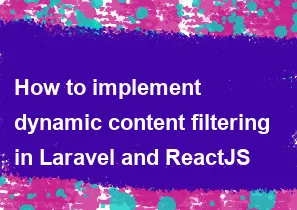How to implement dynamic content filtering in Laravel and ReactJS

Implementing dynamic content filtering in Laravel and ReactJS involves creating a backend in Laravel to handle filtering logic and an interface in ReactJS to interact with the backend. Below is a step-by-step guide:
Laravel Backend:
Install Laravel: Make sure you have Laravel installed. If not, install it using Composer:
bashcomposer create-project --prefer-dist laravel/laravel your-project-nameCreate Model and Migration: Create a model and migration for the data you want to filter.
bashphp artisan make:model YourModel -mEdit the migration file to define the table structure.
Seed the Database: Use seeders or factory classes to populate your database with sample data.
bashphp artisan db:seedCreate Controller: Create a controller to handle filtering logic.
bashphp artisan make:controller YourControllerImplement filtering logic within this controller.
Set Up Routes: Define routes in
routes/web.phporroutes/api.phpfor your filtering operations.Create API Endpoints: Implement API endpoints for filtering in your controller.
ReactJS Frontend:
Set Up React App: Create a new React app using Create React App or your preferred method.
bashnpx create-react-app your-react-appCreate Components: Create React components for displaying the data and filters.
Fetch Data from Backend: Use
fetchor a library like Axios to retrieve data from your Laravel backend.Implement Filtering Logic: Add UI elements for filters, and create functions to update the API calls with the selected filters.
Display Filtered Data: Update the UI to display the filtered data.
Handle User Interactions: Add event handlers to trigger the filtering functions when the user interacts with the filters.
Connecting Laravel and ReactJS:
CORS Configuration: Update your Laravel app to allow CORS (Cross-Origin Resource Sharing). You can use the
barryvdh/laravel-corspackage.bashcomposer require barryvdh/laravel-corsFollow the package documentation to configure it.
API Calls from React: Update your React components to make API calls to your Laravel backend.
Update API Endpoints: Ensure that your React app is making requests to the correct Laravel API endpoints.
Test and Debug: Test your dynamic content filtering system and debug any issues that may arise.
Remember to secure your application by handling user inputs appropriately, validating data, and implementing authentication and authorization as needed.
-
Popular Post
- How to optimize for Google's About This Result feature for local businesses
- How to implement multi-language support in an Express.js application
- How to handle and optimize for changes in mobile search behavior
- How to handle CORS in a Node.js application
- How to use Vue.js with a UI framework (e.g., Vuetify, Element UI)
- How to configure Laravel Telescope for monitoring and profiling API requests
- How to create a command-line tool using the Commander.js library in Node.js
- How to implement code splitting in a React.js application
- How to use the AWS SDK for Node.js to interact with various AWS services
- How to use the Node.js Stream API for efficient data processing
- How to implement a cookie parser middleware in Node.js
- How to implement WebSockets for real-time communication in React
-
Latest Post
- How to implement a dynamic form with dynamic field styling based on user input in Next.js
- How to create a custom hook for handling user interactions with the browser's device motion in Next.js
- How to create a custom hook for handling user interactions with the browser's battery status in Next.js
- How to implement a dynamic form with dynamic field visibility based on user input in Next.js
- How to implement a dynamic form with real-time collaboration features in Next.js
- How to create a custom hook for handling user interactions with the browser's media devices in Next.js
- How to use the useSWRInfinite hook for paginating data with a custom loading indicator in Next.js
- How to create a custom hook for handling user interactions with the browser's network status in Next.js
- How to create a custom hook for handling user interactions with the browser's location in Next.js
- How to implement a dynamic form with multi-language support in Next.js
- How to create a custom hook for handling user interactions with the browser's ambient light sensor in Next.js
- How to use the useHover hook for creating interactive image zoom effects in Next.js